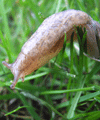July
Grazing slugs hinder grassland restoration

Selective grazing by slugs may prevent key grassland species from taking hold and hamper efforts to restore our hay meadows, new research has shown.
Work by scientists at Newcastle University, UK, has looked at the impact slugs have on grassland biodiversity and how this might inform future restoration work.Although renowned for their ability to chew through a gardener’s prize petunias or strawberry patch, still relatively little is known about the effect these munching molluscs have on large scale grassland conservation projects.
But for the first time this latest research shows that some of the most ecologically important species – such as the red clover – are particularly tasty to slugs, which may reduce the number of seedlings becoming established and overall plant diversity.
Publishing their results next month in a special edition of the academic journal Annals of Botany, the research team has shown the impact of Deroceras reticulatum – otherwise known as the field slug – may need to be managed in order to help seedlings establish and contribute towards successful restoration.
“Herbivory is a fundamental driver of plant diversity,” explains Dr Sarah Barlow, who carried out the work while at Newcastle University and is now based at the Royal Botanic Gardens, Kew.
“We know a lot about the benefits – and drawbacks - of grazing by larger vertebrates such as cows and sheep but we haven’t studied in detail the impact slugs might have, particularly on very young plants in meadows that we are trying to restore.
“What these initial studies have shown is that Deroceras reticulatum may actually be very damaging in this situation due to it finding some key species particularly tasty.
“One of these, red clover, is particularly important due to the symbiotic bacteria which live in its roots and help to fix Nitrogen into the soil, benefitting not just the clover but all the meadow seedlings.”
Only around 5% of the slug pop¬u¬la¬tion is actually above ground at any one time. Deroceras reticulatum prefers to feed above ground and is particularly fond of seedlings, which is why they can have such a devastating impact on this type of conservation project.
The team looked at slug feeding damage to seedling monocultures of 23 meadow species. The severity and rate of damage suffered by each plant species was analysed and each species ranked for their acceptability – and hence potential vulnerability – to slugs in meadows.
Drawing up a ‘hierarchy of acceptability’, the team found the slugs’ favourite five were: yarrow; Yorkshire fog; rough-stalked meadow grass, creeping red fescue and red clover. On the bright side, said Dr Barlow, the slugs did not like the seedlings of some of the desirable wildflowers such as wood cranesbill, rough hawkbit and greater burnet.
Newcastle University’s Dr Gordon Port, a senior lecturer and an expert in pest management said: “Just like us, slugs have their favourites and will eat some plants in preference to others.
“We have to cope with native slugs in our gardens and crops, but this research shows they can be equally damaging in natural systems. If invasive species, like the Spanish slug establish in the UK it will move the battle against slugs to a much higher level.”
Source Information: “The acceptability of meadow plants to the slug Deroceras reticulatum and implications for grassland restoration”, S Barlow, A Close and G Port. Annals of Botany – Seedling Herbivory (special edition), August 2013.
published on: 12 July 2013
